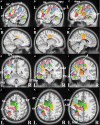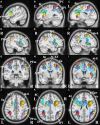A connectivity model of the anatomic substrates underlying Gerstmann syndrome
- PMID: 35706977
- PMCID: PMC9189613
- DOI: 10.1093/braincomms/fcac140
A connectivity model of the anatomic substrates underlying Gerstmann syndrome
Abstract
The Gerstmann syndrome is a constellation of neurological deficits that include agraphia, acalculia, left-right discrimination and finger agnosia. Despite a growing interest in this clinical phenomenon, there remains controversy regarding the specific neuroanatomic substrates involved. Advancements in data-driven, computational modelling provides an opportunity to create a unified cortical model with greater anatomic precision based on underlying structural and functional connectivity across complex cognitive domains. A literature search was conducted for healthy task-based functional MRI and PET studies for the four cognitive domains underlying Gerstmann's tetrad using the electronic databases PubMed, Medline, and BrainMap Sleuth (2.4). Coordinate-based, meta-analytic software was utilized to gather relevant regions of interest from included studies to create an activation likelihood estimation (ALE) map for each cognitive domain. Machine-learning was used to match activated regions of the ALE to the corresponding parcel from the cortical parcellation scheme previously published under the Human Connectome Project (HCP). Diffusion spectrum imaging-based tractography was performed to determine the structural connectivity between relevant parcels in each domain on 51 healthy subjects from the HCP database. Ultimately 102 functional MRI studies met our inclusion criteria. A frontoparietal network was found to be involved in the four cognitive domains: calculation, writing, finger gnosis, and left-right orientation. There were three parcels in the left hemisphere, where the ALE of at least three cognitive domains were found to be overlapping, specifically the anterior intraparietal area, area 7 postcentral (7PC) and the medial intraparietal sulcus. These parcels surround the anteromedial portion of the intraparietal sulcus. Area 7PC was found to be involved in all four domains. These regions were extensively connected in the intraparietal sulcus, as well as with a number of surrounding large-scale brain networks involved in higher-order functions. We present a tractographic model of the four neural networks involved in the functions which are impaired in Gerstmann syndrome. We identified a 'Gerstmann Core' of extensively connected functional regions where at least three of the four networks overlap. These results provide clinically actionable and precise anatomic information which may help guide clinical translation in this region, such as during resective brain surgery in or near the intraparietal sulcus, and provides an empiric basis for future study.
Keywords: Gerstmann’s syndrome; connectivity; connectome; network.
© The Author(s) 2022. Published by Oxford University Press on behalf of the Guarantors of Brain.
Figures









Similar articles
-
Parcellation-based tractographic modeling of the salience network through meta-analysis.Brain Behav. 2022 Jul;12(7):e2646. doi: 10.1002/brb3.2646. Epub 2022 Jun 22. Brain Behav. 2022. PMID: 35733239 Free PMC article.
-
A disconnection account of Gerstmann syndrome: functional neuroanatomy evidence.Ann Neurol. 2009 Nov;66(5):654-62. doi: 10.1002/ana.21776. Ann Neurol. 2009. PMID: 19938150
-
A connectivity model of the anatomic substrates underlying ideomotor apraxia: A meta-analysis of functional neuroimaging studies.Clin Neurol Neurosurg. 2021 Aug;207:106765. doi: 10.1016/j.clineuro.2021.106765. Epub 2021 Jun 17. Clin Neurol Neurosurg. 2021. PMID: 34237682
-
A proposed reinterpretation of Gerstmann's syndrome.Arch Clin Neuropsychol. 2014 Dec;29(8):828-33. doi: 10.1093/arclin/acu056. Epub 2014 Nov 5. Arch Clin Neuropsychol. 2014. PMID: 25377466 Review.
-
What ever happened to developmental Gerstmann's syndrome? Links to other pediatric, genetic, and neurodevelopmental syndromes.J Child Neurol. 2004 Apr;19(4):282-9. doi: 10.1177/088307380401900408. J Child Neurol. 2004. PMID: 15163095 Review.
Cited by
-
Parcellation-based tractographic modeling of the salience network through meta-analysis.Brain Behav. 2022 Jul;12(7):e2646. doi: 10.1002/brb3.2646. Epub 2022 Jun 22. Brain Behav. 2022. PMID: 35733239 Free PMC article.
-
Deconvoluting human Brodmann area 8 based on its unique structural and functional connectivity.Front Neuroanat. 2023 Jun 22;17:1127143. doi: 10.3389/fnana.2023.1127143. eCollection 2023. Front Neuroanat. 2023. PMID: 37426900 Free PMC article. Review.
-
Effect of shunt surgery on idiopathic normal pressure hydrocephalus with incomplete Gerstmann syndrome: A CARE-compliant case report.Medicine (Baltimore). 2025 Aug 1;104(31):e43669. doi: 10.1097/MD.0000000000043669. Medicine (Baltimore). 2025. PMID: 40760575 Free PMC article.
-
Functional connectivity reveals different brain networks underlying the idiopathic foreign accent syndrome.Neurol Sci. 2023 Sep;44(9):3087-3097. doi: 10.1007/s10072-023-06762-4. Epub 2023 Mar 30. Neurol Sci. 2023. PMID: 36995471
-
The Brain Connectome for Clinical Neuroscience.Adv Exp Med Biol. 2024;1462:337-350. doi: 10.1007/978-3-031-64892-2_20. Adv Exp Med Biol. 2024. PMID: 39523275 Review.
References
-
- Gerstmann J. Fingeragnosie-eine umschriebene storung der orientierung am eigenen Korper. Wiener Klinische Wochenschrift. 1924;37:1010–1012.
-
- Roux FE, Boetto S, Sacko O, Chollet F, Trémoulet M. Writing, calculating, and finger recognition in the region of the angular gyrus: a cortical stimulation study of Gerstmann syndrome. J Neurosurg. 2003;99:716–727. - PubMed
-
- Rusconi E. Gerstmann syndrome: historic and current perspectives. Handb Clin Neurol. 2018;151:395–411. - PubMed
-
- Rusconi E, Pinel P, Dehaene S, Kleinschmidt A. The enigma of Gerstmann’s syndrome revisited: a telling tale of the vicissitudes of neuropsychology. Brain. 2009;133:320–332. - PubMed
Grants and funding
LinkOut - more resources
Full Text Sources
Miscellaneous
